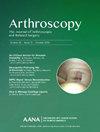关节镜下治疗股骨髋臼撞击症的方法中,髋臼囊修补术、髋臼唇修补术和股骨成形术的应用越来越多
IF 4.4
1区 医学
Q1 ORTHOPEDICS
Arthroscopy-The Journal of Arthroscopic and Related Surgery
Pub Date : 2024-10-01
DOI:10.1016/j.arthro.2024.01.025
引用次数: 0
摘要
我们的研究旨在利用专门用于治疗股骨髋臼撞击综合征(FAIS)的机构数据库,对髋关节镜手术的使用情况进行最新评估。方法在2014年至2022年期间,通过多机构、单一医疗系统数据库中的当前程序术语(CPT)编码,对所有接受髋关节镜手术治疗股骨髋臼撞击综合征的患者进行回顾性鉴定。研究进行了纵向分析,以确定关节镜技术的使用趋势,包括关节囊和髋臼唇治疗、骨成形术和牵引装置。结果在研究期间,共分析了 733 名患者的 789 例髋关节镜手术(56 例为双侧分期手术)。从2016年到2022年,每年进行的髋关节镜手术数量增加了1490%(R2=0.87,P=0.001)。在我们的研究期间,髋臼囊修复术(R2=0.92,p<0.001)、髋臼唇修复术(R2=0.75,p=0.002)和股骨成形术(R2=0.70,p=0.004)的实施比例越来越高,而髋臼唇清创术(R2=-0.84,p<0.001)的使用率越来越低。无后牵引系统用于84%(663/789)的髋关节镜手术,每年至少用于70%的髋关节镜手术,其使用率没有发生任何显著变化(R2=0.02,p=0.73)。临床相关性随着比较文献不断界定髋关节镜的安全性和有效性,了解新技术或新程序如何应用于临床实践非常重要。本文章由计算机程序翻译,如有差异,请以英文原文为准。
Capsular Repair, Labral Repair, and Femoroplasty With Postless Traction Are Increasingly Performed for the Arthroscopic Treatment of Femoroacetabular Impingement Syndrome
Purpose
To provide an updated assessment of hip arthroscopy use by using an institutional database that is specific to the treatment of femoroacetabular impingement syndrome (FAIS).
Methods
All patients undergoing hip arthroscopy for the treatment of FAIS were retrospectively identified between the years 2014 and 2022 via Current Procedural Terminology coding in a multi-institutional, single health system database. A longitudinal analysis was performed to identify trends in the use of arthroscopic techniques including capsular and labral treatment, osteoplasty, and traction set-up.
Results
During the study, 789 arthroscopic hip procedures in 733 patients were analyzed (56 staged bilateral). Between 2016 and 2022, the number of hip arthroscopies performed each year increased by 1,490% (R2 = 0.87, P = .001). Capsular repair (R2 = 0.92, P < .001), labral repair (R2 = 0.75, P = .002), and femoroplasty (R2 = 0.70, P = .004) were performed in an increasing proportion of cases over our study period whereas labral debridement (R2 = –0.84, P < .001) became less used. Postless traction systems were employed in 84% (663/789) of hip arthroscopies overall, were used in at least 70% of hip arthroscopies each year, and did not undergo any significant changes in use (R2 = 0.02, P = .73).
Conclusions
Capsular repair, labral repair, and femoroplasty were increasingly performed for the arthroscopic treatment of FAIS whereas the use of labral debridement decreased significantly over our study period. Postless traction systems were used in the majority of cases each year.
Clinical Relevance
As comparative literature continues to define the safety and efficacy of hip arthroscopy, understanding how novel techniques or procedures are incorporated in clinical practice is important.
求助全文
通过发布文献求助,成功后即可免费获取论文全文。
去求助
来源期刊
CiteScore
9.30
自引率
17.00%
发文量
555
审稿时长
58 days
期刊介绍:
Nowhere is minimally invasive surgery explained better than in Arthroscopy, the leading peer-reviewed journal in the field. Every issue enables you to put into perspective the usefulness of the various emerging arthroscopic techniques. The advantages and disadvantages of these methods -- along with their applications in various situations -- are discussed in relation to their efficiency, efficacy and cost benefit. As a special incentive, paid subscribers also receive access to the journal expanded website.

 求助内容:
求助内容: 应助结果提醒方式:
应助结果提醒方式:


